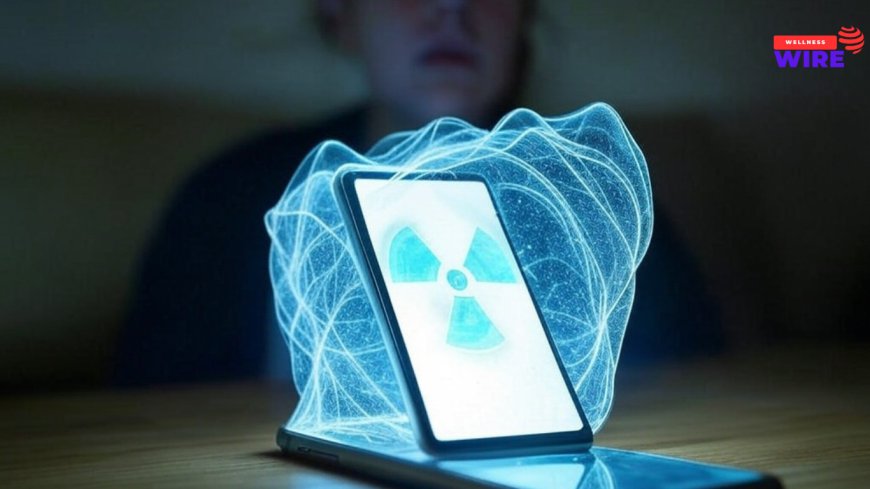EMF Radiation and Smartphones: Should You Be Worried?
Does smartphone EMF radiation pose health risks? Learn about potential dangers, cancer links, fertility concerns, and how to reduce exposure.

Introduction
Smartphones have become an inseparable part of modern life. From work to socializing, entertainment to navigation, we rely on them more than ever. But with this convenience comes growing concerns about electromagnetic field (EMF) radiation emitted by these devices.
Many people wonder: Does smartphone radiation pose a serious health risk? Could long-term exposure lead to cancer, neurological disorders, or fertility issues? While some experts argue that EMF radiation is harmless, others warn of potential dangers that need more investigation.
This article dives deep into the science of EMF radiation, its potential health risks, and how you can reduce exposure without giving up your smartphone.
What Is EMF Radiation?
Electromagnetic fields (EMFs) are invisible energy waves produced by electrically charged objects. They are categorized into two main types:
1. Ionizing Radiation (High-Frequency) – Proven Harmful
This includes X-rays, gamma rays, and ultraviolet (UV) rays, which have enough energy to break molecular bonds in DNA, leading to mutations and cancer.
2. Non-Ionizing Radiation (Low-Frequency) – Controversial
This includes radiofrequency (RF) radiation from smartphones, Wi-Fi, Bluetooth, and microwaves. It does not have enough energy to directly damage DNA but may still affect biological functions.
Smartphones primarily emit radiofrequency (RF) radiation, a type of non-ionizing EMF. The World Health Organization (WHO) and the International Agency for Research on Cancer (IARC) have classified RF radiation as "possibly carcinogenic to humans" (source).
Do Smartphones Emit Dangerous Levels of Radiation?
Every smartphone emits radiofrequency (RF) radiation, measured in Specific Absorption Rate (SAR)—the rate at which the body absorbs EMF energy. The Federal Communications Commission (FCC) in the U.S. has set SAR limits at 1.6 watts per kilogram (W/kg) for public safety (source).
Smartphone SAR Levels (Measured in W/kg):
- Apple iPhone 14 Pro – 1.15 W/kg
- Samsung Galaxy S23 Ultra – 1.03 W/kg
- Google Pixel 7 – 1.35 W/kg
- Motorola Edge 2022 – 1.79 W/kg (one of the highest)
While these levels are within FCC limits, some experts argue that long-term exposure may still have biological effects.
Potential Health Risks of EMF Radiation
While research is ongoing, several studies have raised concerns about prolonged smartphone use and EMF exposure.
1. Increased Cancer Risk? The Ongoing Debate
One of the biggest concerns is whether smartphone radiation can cause or contribute to cancer.
- A 2018 study by the U.S. National Toxicology Program (NTP) found that male rats exposed to high levels of RF radiation developed tumors in the heart and brain (source).
- A 2011 study published in The Lancet Oncology classified RF radiation as a possible carcinogen due to links with gliomas (brain tumors) and acoustic neuromas (source).
However, critics argue that these studies used higher RF levels than what humans are exposed to and that epidemiological studies in humans have shown mixed results.
2. Potential Effects on Brain Function and Sleep
Frequent smartphone use, especially at night, has been linked to sleep disturbances and cognitive issues.
- Melatonin Disruption: EMFs and blue light from screens suppress melatonin, a hormone crucial for sleep. A study in The Journal of Clinical Endocrinology & Metabolism found that screen exposure before bed reduced melatonin levels by 23% (source).
- Memory and Attention Problems: A Swiss study found that smartphone radiation can affect memory performance, particularly in adolescents (source).
3. Potential Fertility Issues
Some studies suggest EMF exposure may affect male fertility by reducing sperm count and motility.
- A 2014 study in The Central European Journal of Urology found that RF radiation from phones carried in pockets was linked to lower sperm quality (source).
- A 2018 meta-analysis found consistent evidence that EMF exposure negatively impacts sperm function (source).
4. Links to Neurological Disorders and Mental Health
Emerging research suggests long-term EMF exposure may be linked to anxiety, depression, and neurodegenerative diseases.
- A 2022 study published in Environmental Research found an association between high EMF exposure and increased oxidative stress in brain cells, which may contribute to Alzheimer’s and Parkinson’s disease (source).
- Some researchers believe that EMFs alter neurotransmitter function, potentially increasing stress and anxiety levels.
How to Reduce EMF Exposure Without Giving Up Your Smartphone
While there is no definitive proof that smartphone radiation is dangerous, it’s wise to take precautionary measures—especially since EMF exposure is cumulative.
1. Use Speakerphone or Headphones
Holding your phone directly against your head increases RF absorption. Instead, use:
✅ Wired headphones (Best option)
✅ Air tube headsets (Reduce radiation exposure)
✅ Speakerphone mode (Limits direct contact)
2. Keep Your Phone Away from Your Body
- Avoid carrying your phone in your pocket or bra.
- Use a bag or keep it on a desk when not in use.
- Do not sleep with your phone under your pillow.
3. Text More, Talk Less
Texting minimizes direct RF exposure to the head compared to holding the phone against your ear.
4. Enable Airplane Mode When Not Needed
Switch to Airplane Mode when sleeping or when you don’t need connectivity. This disables EMF emissions from cellular, Wi-Fi, and Bluetooth signals.
5. Use EMF Protection Shields (With Caution)
There are EMF-blocking phone cases and anti-radiation stickers, but scientific evidence on their effectiveness is limited. Some products may even force your phone to increase power output, leading to higher radiation levels.
Conclusion: Should You Be Worried?
The debate over smartphone EMF radiation and health risks is far from settled. While current scientific evidence does not confirm a direct link to serious diseases, some studies suggest potential long-term effects. Given the uncertainty, it’s wise to take simple precautions to reduce exposure—especially since EMF exposure from wireless devices is increasing exponentially.
Governments, scientists, and regulatory agencies must continue researching this issue to ensure public safety in an increasingly connected world. Until then, small lifestyle changes can help minimize risks without sacrificing the convenience of modern technology.
What's Your Reaction?
 Like
0
Like
0
 Dislike
0
Dislike
0
 Love
0
Love
0
 Funny
0
Funny
0
 Angry
0
Angry
0
 Sad
0
Sad
0
 Wow
0
Wow
0



















































